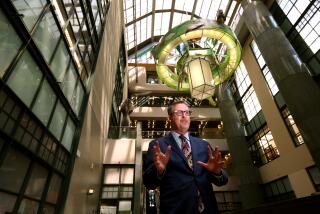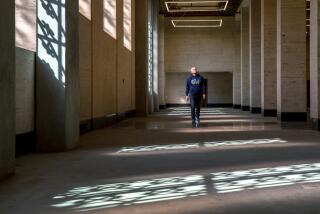Young Campus Breaks Ground for Library
Tying together the university’s historic past with its ambitious future, Cal State Channel Islands officials broke ground Friday on a $50-million library that will serve as the intellectual heart of the Camarillo-area campus.
Work already has begun on a two-story, glass-and-steel structure designed to complement the university’s Spanish-style architecture and feature a book collection that over time is expected to grow to 250,000 volumes.
The library, which is scheduled to open in early 2008, will fit like a puzzle piece into a mothballed medical building left over from the days when the property was home to Camarillo State Hospital, once one of the nation’s preeminent mental health institutions.
In addition to the new construction, the hospital building will be renovated to provide study rooms, computer labs and library offices.
On a lawn in the shadow of where the library will emerge, hundreds gathered Friday morning to watch officials turn the first mounds of earth. They included 165 students from a Camarillo charter school slated one day to move to the Channel Islands campus.
“We look forward to the day when these students and countless others will be able to avail themselves of this extraordinary high-tech, state-of-the-art library,” university President Richard Rush said. “This design will transform an abandoned building into a thriving, dynamic hub of intellectual activity.”
The library helped to break new ground in another way for Cal State Channel Islands, which opened in 2002 and remains the newest school in the 23-campus Cal State University system. The project generated the university’s first significant donation, a $5-million pledge in 1999 from Oxnard rancher John S. Broome, for whom the library will be named.
Broome’s gift was earmarked for creation of the library and has funded its design.
The university commissioned architect Norman Foster, winner of the 1999 Pritzker Prize for architecture, to design the 160,000-square-foot facility, a move that Channel Islands officials said would result in creation of a signature building to rival any on a university campus.
Designs by the British architect include the Great Court at the British Museum and Hong Kong International Airport. Foster also drew up plans for renovation of Berlin’s historic Reichstag, which in 1999 was reinstated as the seat of the German government.
Foster has completed several projects in the United States, including two at Stanford University.
The Reichstag displayed Foster’s ability to blend the old with the new, a sensitivity he also applied in Camarillo.
“I think what we all together have created ... is a place that really invites active, free thought,” said Pedro Haberbosch, who oversees the Camarillo project for Foster’s London-based firm. “It will be a place that brings people together.”
The project has not been universally embraced. There was concern from some in the community about how the library’s modern architecture would fit with the stately Depression-era buildings of the campus’ core. Some criticized the university’s decision to bulldoze a 1950s-era building, which served as administration headquarters for the hospital and the campus for a few years.
The project also ran into construction delays, in part because of rising costs of labor and materials.
Originally, the library was to be built for about $37.5 million, and construction was to begin in late 2003. But bids ranged from $45 million to $49 million, forcing university officials to employ a bidding process that required contractors not to exceed $44 million. That money will come from Cal State University revenue bonds, which will be repaid through income-generating ventures such as the University Glen housing development under construction on a corner of the campus.
Additional money needs to be raised to make up the difference in construction costs and in what will be needed to equip the facility.
To hold down expenses, Foster, university officials and former Channel Islands President Handel Evans have found ways to shave millions by modifying the library’s design.
Evans, a trained architect and college classmate of Foster, was the one who persuaded his old school chum to take on the library project.
“It is the beginning of what we hope will be a world-class university,” said Evans, whose name will grace the library’s main conference room in recognition of his work.
In the days before the groundbreaking, workers scrambled to pull heavy red tiles off the roof of the shuttered administration building in preparation for its demolition. Just behind it, the old receiving and treatment building sat dark and empty, a shell of the place where doctors once studied mental disorders and performed medical procedures.
But touring its dirty, disheveled corridors recently, chief librarian Paul Adalian said he could easily see how one day it would become the academic heart of the burgeoning campus.
Stepping into the building, Adalian said he could visualize a spacious reading room and towering glass-encased book stacks, which will allow patrons to view the entire book collection. He could see where study areas will go, spaces that will allow students to tap the library’s 130,000 digital books or study all night, in their pajamas if they want, during finals.
Out front, he could picture creation of a canopy-shaded plaza, a communal area sure to become a central gathering point.
“It’s going to be the most dramatic entrance of any library in the state,” Adalian said. “We’re taking an abandoned building and bringing it back to life. It will be a landmark for the university and for the community.”
More to Read
Sign up for Essential California
The most important California stories and recommendations in your inbox every morning.
You may occasionally receive promotional content from the Los Angeles Times.










